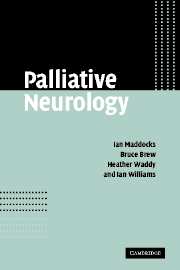Book contents
- Frontmatter
- Contents
- Foreword
- Note on drugs and abbreviations
- Section I Palliative Management
- 1 Introduction to palliation
- 2 Characteristics of palliation
- 3 Nodal points in decision-making
- 4 Common deficiencies in palliative management
- 5 Common themes in palliation practice
- Section II Major discomforts in advanced neurological illness
- Section III Major neurological conditions requiring palliation
- Section IV Ethical issues
- Section V Appendices
- Index
5 - Common themes in palliation practice
from Section I - Palliative Management
Published online by Cambridge University Press: 08 January 2010
- Frontmatter
- Contents
- Foreword
- Note on drugs and abbreviations
- Section I Palliative Management
- 1 Introduction to palliation
- 2 Characteristics of palliation
- 3 Nodal points in decision-making
- 4 Common deficiencies in palliative management
- 5 Common themes in palliation practice
- Section II Major discomforts in advanced neurological illness
- Section III Major neurological conditions requiring palliation
- Section IV Ethical issues
- Section V Appendices
- Index
Summary
There are common themes within palliation practice that have relevance to many of the diseases under consideration and the common discomforts that are experienced:
Holism: considering multiple interactions and influences.
Recording observations of distress: analogue scales.
Involving the team: communicating, recording and supporting.
No correct answer: innovation and experiment.
Appropriate therapy regimens.
Support of carers.
Working with complementary and alternative medicine.
HOLISM
Holism was a term coined by the South African philosopher and statesman Jan Christian Smuts. It signifies that an entity is more than the sum of its parts, that it will not be fully understood by analysis, but will also need an appreciation of its operation as a whole, and the many relationships that bear upon it.
The term has been well received by practitioners of palliation, who recognize that disability, discomfort and dependency (common outcomes of neurological disease) create a complex pattern of distress that is not satisfactorily described as a list of symptoms, but needs also an awareness of the way daily life of the affected individual has been changed in its physical, emotional and spiritual components. Spiritual and emotional needs are just as real as physical ones, and may need to be approached by persons drawn from outside the conventional medical scene.
- Type
- Chapter
- Information
- Palliative Neurology , pp. 33 - 42Publisher: Cambridge University PressPrint publication year: 2005



